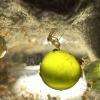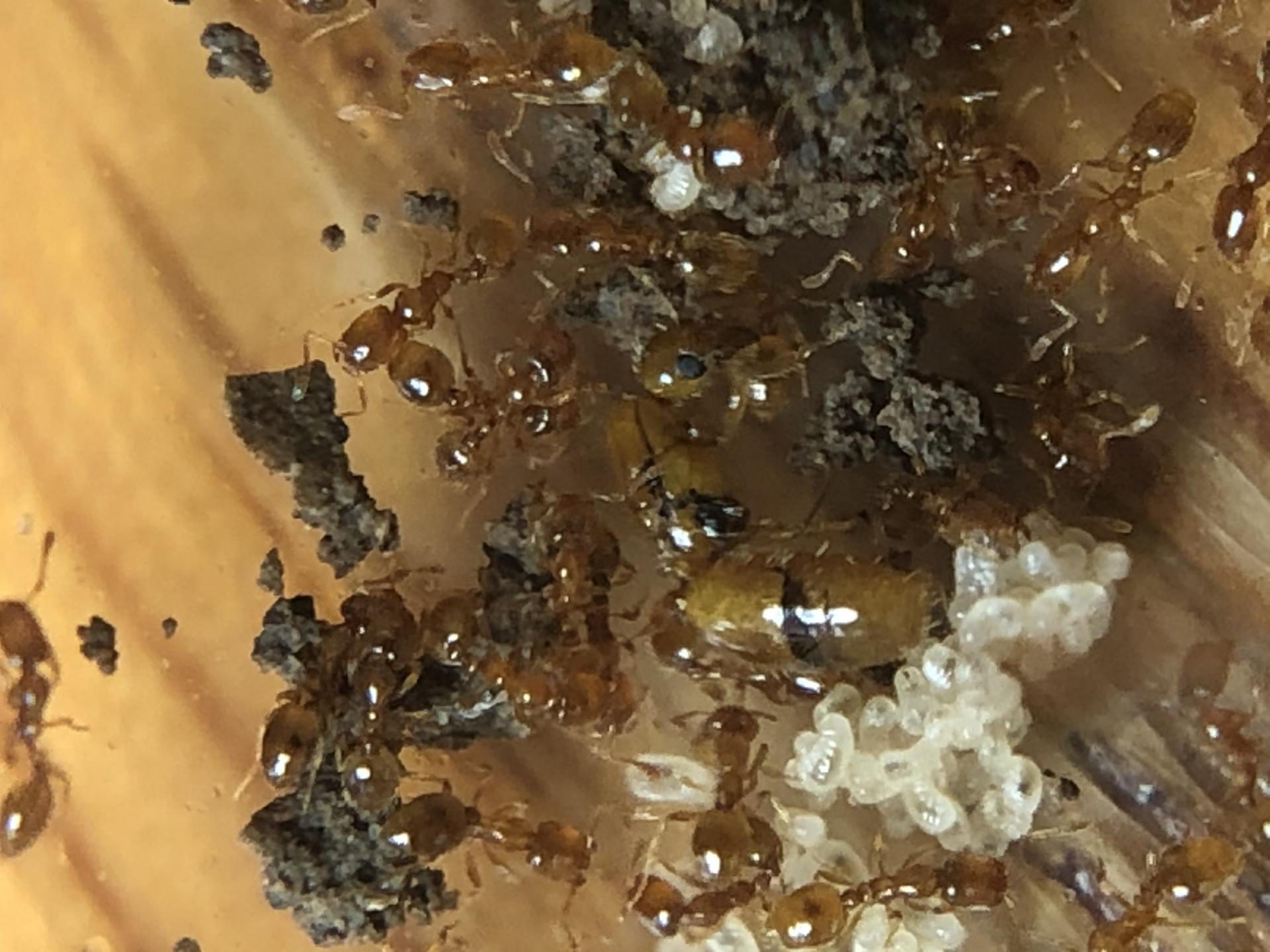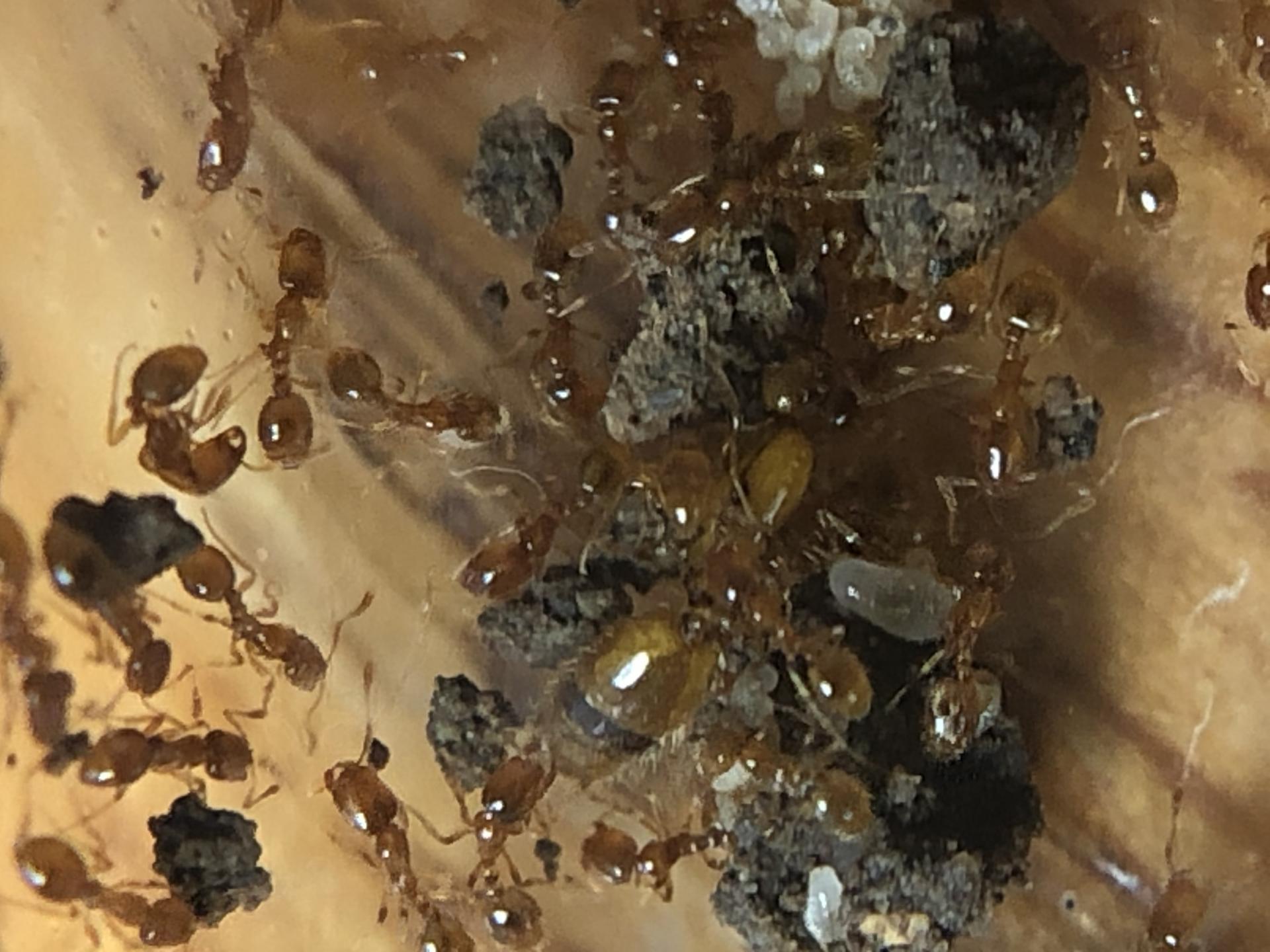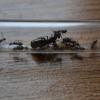- Formiculture.com
- Forums
- Gallery
- Members
- Member Map
- Chat

18 replies to this topic
#1
 Offline
-
Posted February 12 2020 - 12:56 PM
Offline
-
Posted February 12 2020 - 12:56 PM
Found this girl in Northern California today under a stone the workers look no different in color and size than solenopsis molesta but queen is very yellow and has distinct black stripe
#2
 Offline
-
Posted February 12 2020 - 1:52 PM
Offline
-
Posted February 12 2020 - 1:52 PM
No way to tell with these pictures. One thing is for sure though: she's in the Solenopsis fugax complex, in the molesta group. I would invest in a good microscope and put her though a key.
Edited by Ant_Dude2908, February 12 2020 - 1:53 PM.
My Main Journal | My Neivamyrmex Journal | My Ant Adoption | My YouTube
Join the TennesseeAnts Discord Server! https://discord.gg/JbKwPgs
#3
 Offline
-
Posted February 12 2020 - 1:57 PM
Offline
-
Posted February 12 2020 - 1:57 PM
I’m more curious if any one has ever seen that black stripe
I’m pretty sure it’s solenopsis molesta
I’m pretty sure it’s solenopsis molesta
#4
 Offline
-
Posted February 12 2020 - 2:45 PM
Offline
-
Posted February 12 2020 - 2:45 PM
I would just settle with the ID of molesta group Solenopsis sp., because it is unlikely you'll get an accurate species ID for a subterranean Solenopsis in California when their taxonomy is still so unsettled.
Side note, the fugax complex is an entirely separate complex from the molesta complex.
- Martialis, TennesseeAnts and Ferox_Formicae like this
#5
 Offline
-
Posted February 12 2020 - 3:40 PM
Offline
-
Posted February 12 2020 - 3:40 PM
There's actually no way to tell whether these are from the molesta complex, fugax complex, or another complex altogether. I'd just leave them at Solenopsis for now until higher magnification/better photos are available to run these through a key.
- Da_NewAntOnTheBlock likes this
Currently Keeping:
Camponotus chromaiodes, Camponotus nearcticus, Stigmatomma pallipes, Strumigenys brevisetosa, Strumigenys clypeata, Strumigenys louisianae, Strumigenys membranifera, Strumigenys reflexa, Strumigenys rostrata
#6
 Offline
-
Posted February 12 2020 - 3:43 PM
Offline
-
Posted February 12 2020 - 3:43 PM
Looks very physcogastric, that's for sure
There is a important time for everything, important place for everyone, an important person for everybody, and an important ant for each and every ant keeper and myrmecologist alike
#7
 Offline
-
Posted February 12 2020 - 3:46 PM
Offline
-
Posted February 12 2020 - 3:46 PM
Looks very physcogastric, that's for sure
Nope, that's a normal sized Solenopsis gaster. If she were physogastric, you could see the tergites stretching and the softer stretchy 'skin' underneath.
Currently Keeping:
Camponotus chromaiodes, Camponotus nearcticus, Stigmatomma pallipes, Strumigenys brevisetosa, Strumigenys clypeata, Strumigenys louisianae, Strumigenys membranifera, Strumigenys reflexa, Strumigenys rostrata
#8
 Offline
-
Posted February 12 2020 - 3:48 PM
Offline
-
Posted February 12 2020 - 3:48 PM
All that is good info In all but in any ones experience have they seen the racing stripe she has on her gaster???? I’ve seen hundreds of solenopsis colony near where I found her and never seen a racing stripe on a gaster.thoughts???
#9
 Offline
-
Posted February 12 2020 - 3:50 PM
Offline
-
Posted February 12 2020 - 3:50 PM
Leave it at Solenopsis, even with a good scope and key a species level Id is going to be virtually impossible.
#10
 Offline
-
Posted February 12 2020 - 4:06 PM
Offline
-
Posted February 12 2020 - 4:06 PM
Looks very physcogastric, that's for sure
Nope, that's a normal sized Solenopsis gaster. If she were physogastric, you could see the tergites stretching and the softer stretchy 'skin' underneath.
wow, that's crazy!
There is a important time for everything, important place for everyone, an important person for everybody, and an important ant for each and every ant keeper and myrmecologist alike
#11
 Offline
-
Posted February 12 2020 - 4:12 PM
Offline
-
Posted February 12 2020 - 4:12 PM
I would just settle with the ID of molesta group Solenopsis sp., because it is unlikely you'll get an accurate species ID for a subterranean Solenopsis in California when their taxonomy is still so unsettled.
Side note, the fugax complex is an entirely separate complex from the molesta complex.
Oh. I don't know what I was thinking...
My Main Journal | My Neivamyrmex Journal | My Ant Adoption | My YouTube
Join the TennesseeAnts Discord Server! https://discord.gg/JbKwPgs
#12
 Offline
-
Posted February 12 2020 - 4:21 PM
Offline
-
Posted February 12 2020 - 4:21 PM
lol, it's fine, we all have those days lol
There is a important time for everything, important place for everyone, an important person for everybody, and an important ant for each and every ant keeper and myrmecologist alike
#13
 Offline
-
Posted February 12 2020 - 4:23 PM
Offline
-
Posted February 12 2020 - 4:23 PM
But what about the black stripe on the gaster?????????? Lol
#14
 Offline
-
Posted February 12 2020 - 5:48 PM
Offline
-
Posted February 12 2020 - 5:48 PM
Sometimes a black stripe is just a black stripe.
#15
 Offline
-
Posted February 12 2020 - 6:43 PM
Offline
-
Posted February 12 2020 - 6:43 PM
Very attractive feature though. Wish we had Solenopsis like that here.
#16
 Offline
-
Posted February 12 2020 - 6:49 PM
Offline
-
Posted February 12 2020 - 6:49 PM
Here, they have a black dot on the bottom of the gaster.
Hi there! I went on a 6 month or so hiatus, in part due, and in part cause of the death of my colonies.
However, I went back to the Sierras, and restarted my collection, which is now as follows:
Aphaenogaster uinta, Camponotus vicinus, Camponotus modoc, Formica cf. aserva, Formica cf. micropthalma, Formica cf. manni, Formica subpolita, Formica cf. subaenescens, Lasius americanus, Manica invidia, Pogonomyrmex salinus, Pogonomyrmex sp. 1, Solenopsis validiuscula, & Solenopsis sp. 3 (new Sierra variant).
#17
 Offline
-
Posted February 12 2020 - 6:54 PM
Offline
-
Posted February 12 2020 - 6:54 PM
In ohio we have texana, carolinensis, and molesta, but you ONLY find molesta the other 2 are in the extreme south
#18
 Offline
-
Posted February 12 2020 - 7:29 PM
Offline
-
Posted February 12 2020 - 7:29 PM
Here, they have a black dot on the bottom of the gaster.
Yeah, I see that on all my queens too. Sometimes on Forelius as well, but with workers.
#19
 Offline
-
Posted February 12 2020 - 8:23 PM
Offline
-
Posted February 12 2020 - 8:23 PM
Here, they have a black dot on the bottom of the gaster.
Yeah, I see that on all my queens too. Sometimes on Forelius as well, but with workers.
That's actually their crop, not an actual spot on the cuticle. It's easily seen on ants when seen through a microscope. It seems to be very apparent when I look at my Crematogaster minutissima and Camponotus castaneus. It's really only visible on ants with light colored cuticles, which is why you see it on such ants as Solenopsis thief ants and Forelius.
Currently Keeping:
Camponotus chromaiodes, Camponotus nearcticus, Stigmatomma pallipes, Strumigenys brevisetosa, Strumigenys clypeata, Strumigenys louisianae, Strumigenys membranifera, Strumigenys reflexa, Strumigenys rostrata
Also tagged with one or more of these keywords: ant i’d
Anting →
Ant ID Requests →
Ant ID request (2)Started by DrygonKing , Jul 11 2018 |
|

|
||
Anting →
Ant ID Requests →
Is this even an ant?Started by DrygonKing , May 28 2018 |
|

|
0 user(s) are reading this topic
0 members, 0 guests, 0 anonymous users





















